Financial Services Business Plan
Green Investments (GI) is a financial service company specializing in stocks of environmentally responsible companies. The Washington-based L.L.C. is led by Sarah Lewis and Steve Burke. GI utilizes financial research from Bear Stearns and in-house environmental responsibility analysis to advise clients.
Services:
GI has developed a criteria-based marker system to evaluate companies’ environmental impact effectively. Only financially prudent companies are evaluated, ensuring that recommendations are financially and environmentally sound.
Competitive Edge:
GI will leverage the proprietory evaluation system to rapidly gain market share. The system is convenient and based on extensive research, providing a streamlined overview of companies’ environmental performance.
Market:
GI will focus on the unserved niche of environmental investing within the financial services market. GI faces indirect competition from environmentally responsible mutual funds, which assess a company’s environmental performance but do not allow for individual equity investment.
Management Team:
GI is led by two experienced managers, Sarah Lewis and Steve Burke. Sarah holds a masters degree in environmental studies and has worked for the Environmental Protection Agency, where she prepared environmental impact statements. Steve has an MBA and has developed an extensive network of contacts while working for Salomon Smith Barney.
GI addresses a previously ignored niche in the financial services market. GI projects sales of $230,000 and $261,000 in years two and three, respectively.
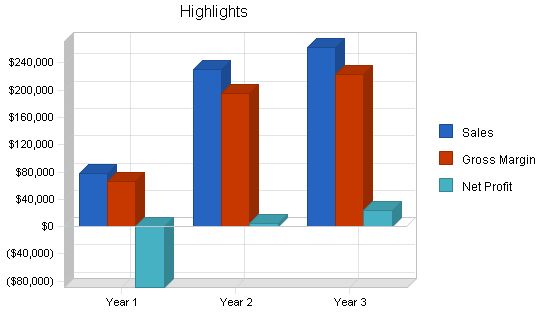
Contents
1.1 Objectives
- To become the premier environmental investment firm.
- Attract more people to invest in environmentally responsible companies.
- Continue to reduce costs associated with environmental investment research.
1.2 Mission
Green Investments’ mission is to be the premier financial service organization for investing in environmentally responsible companies. Through comprehensive research and verifiable criteria, Green Investments identifies sound environmental investments. By offering high-level services, Green Investments will succeed as a company and have a positive impact on the environment.
1.3 Keys to Success
- Develop accurate environmental markers for assessing a company’s environmental impacts.
- Purchase high-quality investment research from recognized firms.
- Price the service competitively with a good profit margin.
Company Summary
Green Investments is a Washington-based financial service company specializing in environmentally responsible companies. It is owned by Steve Burke and Sarah Lewis and is registered as a L.L.C.
2.1 Start-up Summary
The following equipment is needed for start-up:
- Phone system (5 line).
- Workstation computers (4), back-end server, DSL Internet connection, and laser printer.
- Office furniture, meeting room and waiting room furniture.
- Monthly service charge for Bear Stearns software.
- Fax machine, copier, lighting, and assorted office supplies.
2.2 Company Ownership
Steve Burke and Sarah Lewis equally own Green Investments. They initially planned to form a S Corporation, but decided on a L.L.C. to avoid double taxation while still enjoying the benefits of personal liability avoidance.
Services
Green Investments offers investment advice for stocks. It purchases financial performance research from Bear Stearns, a highly respected firm. In addition to financial performance criteria, Green Investments has developed environmental markers to evaluate a company’s environmental impact. The markers include energy usage, water usage, recycling programs, paper consumption, chemical cleaning usage, ground maintenance impact, formal environmental policies, and recycling rates. Green Investments applies these markers to recommended investments from Bear Stearns to create a list of recommended stocks with strong financial and environmental performance.
Green Investments charges a service fee similar to standard brokerage firms, but slightly higher due to the additional research required. However, the price difference is not significant, especially for customers who want to invest in environmentally sound companies.
Recent studies have shown that "green" stocks perform well. Companies that prioritize environmental considerations tend to perform better.
Market Analysis Summary
Green Investments targets two customer segments: households with less than $1 million, and households with more than $1 million in wealth. Both groups are concerned with the environment and make investment decisions based on companies with strong economic and environmental performance records.
The financial services industry has various niches, and Green Investments specifically focuses on environmentally responsible companies.
4.1 Market Segmentation
Green Investments has segmented the target market into two groups based on household wealth: less than $1 million and more than $1 million.
- Customers with less than $1 million are middle-class individuals who invest in moderately risky stocks and allocate 35%-45% of their portfolio to stocks.
- Customers with more than $1 million are upper-middle class to upper class individuals who prioritize return on investments and have environmental concerns.
Both segments share characteristics such as choosing environmentally friendly vehicles, actively recycling, and making retail purchases with environmental considerations in mind. They are also more likely to engage in human-powered outdoor activities.
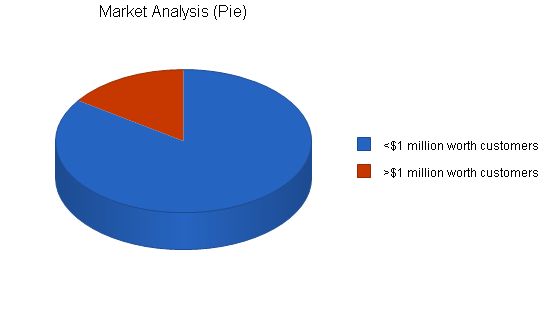
Year 1 Year 2 Year 3 Year 4 Year 5 CAGR
Potential Customers Growth 8% 1,232,000 1,330,560 1,437,005 1,551,965 1,676,122 8.00%
>$1 million worth customers 7% 223,090 238,706 255,415 273,294 292,425 7.00%
Total 7.85% 1,455,090 1,569,266 1,692,420 1,825,259 1,968,547 7.85%
4.2 Target Market Segment Strategy:
Green Investments has chosen these target market segments because of their ideological beliefs and the corresponding need for services that Green Investments can provide. While people can buy shares of an environmentally responsible mutual fund to act on their beliefs, mutual funds are just one type of investment. The downside of investments is their relatively low rate of return compared to good stocks, limited personalized service, and the inability to make custom choices beyond the type of mutual fund.
Therefore, Green Investments has chosen these customer segments because they have unmet needs. These groups have the financial means and desire for environmental investments, but their only current option is a mutual fund. Green Investments has differentiated these market segments based on household worth, as this characteristic provides useful behavioral information.
4.3 Service Business Analysis:
Green Investments operates in the financial service industry, a multi-billion dollar industry providing a range of financial services such as investments. This industry offers various investment options, including but not limited to bonds, treasury bills, stocks, mutual funds, insurance policies, annuities, and IRAs.
Within the industry, customers are served by large national firms like Merrill Lynch or Charles Schwab, franchises, individual firms, and online brokers. Buying decisions are often influenced by personal familiarity with a specific company. Most service providers offer a similar menu of investment options.
Fee structures vary, with some firms charging a percentage based on the client’s investment amount and others using hourly rates or quarterly management fees. Some service providers offer flexibility to work with customers in creating special arrangements.
4.3.1 Competition and Buying Patterns:
Green Investments faces no direct competitors offering environmentally sound stock investment services. The current environmental investment options are all mutual fund-based, such as Janus, Citizen Funds, Sierra Club Environmental Fund, and Portfolio 21.
Green Investments also competes with a range of financial advisors who provide various investment options. However, these competitors do not independently research the environmentalism of different companies.
Strategy and Implementation Summary:
Green Investments differentiates itself through independent environmental research based on custom criteria for objectively measuring a company’s dedication to environmentalism. This competitive edge is marketed using the slogan "think globally, act locally," inspiring people to contribute to the environment through responsible investing. The sales campaign emphasizes the superior performance of environmental investments compared to the S&P 500 Index.
5.1 Competitive Edge:
Green Investments’ competitive edge lies in its environmental marker criteria that identify economically performing companies with solid environmental commitments. These markers are valuable because they are based on extensive research, provide comparability with similar businesses, and are easier to use than large-scale internal audits. The objective and accurate measurement system offered by Green Investments is unique and serves as an information source for stock investment decision-making.
5.2 Marketing Strategy:
Green Investments’ marketing effort revolves around the mantra "think globally, act locally" to encourage people to make investments based on their conscience. The company promotes the idea that responsible investing has no real cost compared to other options and offers better returns than the S&P 500 Index. Magazine advertisements and community-based marketing activities, such as networking, sponsorship, and participation in seminars, increase awareness of Green Investments and its services.
5.3 Sales Strategy:
The sales strategy focuses on providing quantitative evidence that Green Investments’ recommended companies outperform the S&P 500 Index. Green Investments’ chosen companies outperformed the index by 2.4% in 1999-2001. A sales packet is distributed to prospective customers, highlighting the historic returns of recommended companies.
5.3.1 Sales Forecast:
The sales forecast is conservative to avoid inflated expectations. The initial months will be slow, but Green Investments projects steady, incremental growth in sales. This growth is attributed to increased sales proficiency and awareness among the target customers.
Please refer to the table and chart below for numerical and graphical representations of the future year’s sales forecasts.
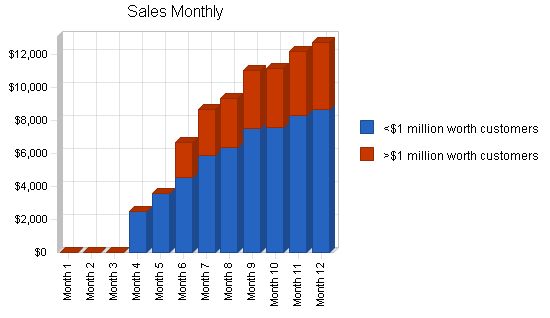
Sales Forecast
Year 1 Year 2 Year 3
Sales $54,746 $156,665 $178,225
>$1 million worth customers $22,889 $73,633 $83,766
Total Sales $77,635 $230,298 $261,991
Direct Cost of Sales
Year 1 Year 2 Year 3
$8,212 $23,500 $26,734
>$1 million worth customers $3,433 $11,045 $12,565
Subtotal Direct Cost of Sales $11,645 $34,545 $39,299
5.4 Milestones
Green Investments has identified several milestones that will act as ambitious yet achievable goals for the organization. By establishing these goals, the organization will develop an implicit incentive for all members to work hard.
– Business plan completion: The business plan is the roadmap for the organization and forces analysis of a multitude of issues.
– First account of over $1 million invested: This would be a significant amount for both an individual account and the organization, and they will strive to achieve many of these customers.
– Profitability: An eventual necessity.
– Revenue of $250,000: With the achievement of this milestone and the previous one, it will reaffirm the success of the business model.
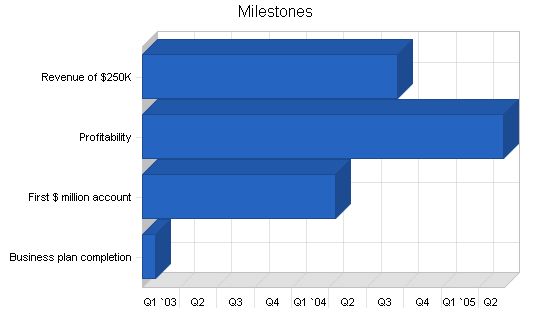
Milestones:
| Milestones | |||||
| Milestone | Start Date | End Date | Budget | Manager | Department |
| Business plan completion | 1/1/2003 | 2/1/2003 | $0 | Sarah & Steve | Planning |
| First $ million account | 1/1/2003 | 4/15/2004 | $0 | Sarah | Sales |
| Profitability | 1/1/2003 | 6/1/2005 | $0 | Steve | Accounting |
| Revenue of $250K | 1/1/2003 | 9/15/2004 | $0 | Sarah | Sales |
| Totals | $0 | ||||
Management Summary:
Green Investments will be led by the founding team of Sarah Lewis and Steve Burke. Sarah has an undergraduate and Masters in environmental studies from the University of Burlington. After obtaining her degrees, she moved to Washington DC where she worked for the Environmental Protection Agency (EPA) for four years, performing environmental impact statements for various industries, companies, and projects. Sarah was also a project manager for Janus in their evaluation department, where they conducted company-wide environmental assessments of potential investments for the fund.
The other member of Green Investments’ management team is Steve Burke. Steve comes from a financial background, with an undergraduate degree in Finance from Seattle University and an MBA from the University of Washington. After completing his education, Steve worked for Salomon Smith Barney in their investment department for eight years.
Personnel Plan:
- Sarah: Company research, development of markers, sales.
- Steve: Sales, accounting and finance, account management, marketing.
- Account manager: Customer support for investment accounts.
- Administrative assistant: Assorted tasks.
- Bookkeeper: Handles day-to-day accounts receivables and payable duties.
- Research assistant: Assists Sarah with research.
The positions will be phased in as needed. Please refer to the following chart for personnel forecasts.
| Personnel Plan | |||
| Year 1 | Year 2 | Year 3 | |
| Sarah | $30,000 | $40,000 | $40,000 |
| Steve | $30,000 | $40,000 | $40,000 |
| Account Manager | $27,000 | $36,000 | $36,000 |
| Administrative Assistant | $15,000 | $15,000 | $15,000 |
| Bookkeeper | $10,000 | $12,000 | $12,000 |
| Research Assistant | $8,250 | $9,000 | $9,000 |
| Total People | 6 | 6 | 6 |
| Total Payroll | $120,250 | $152,000 | $152,000 |
The following sections will outline important financial information.
Important Assumptions:
| General Assumptions | |||
| Year 1 | Year 2 | Year 3 | |
| Plan Month | 1 | 2 | 3 |
| Current Interest Rate | 10.00% | 10.00% | 10.00% |
| Long-term Interest Rate | 10.00% | 10.00% | 10.00% |
| Tax Rate | 30.00% | 30.00% | 30.00% |
| Other | 0 | 0 | 0 |
The Break-even Analysis is shown in the following table and chart.
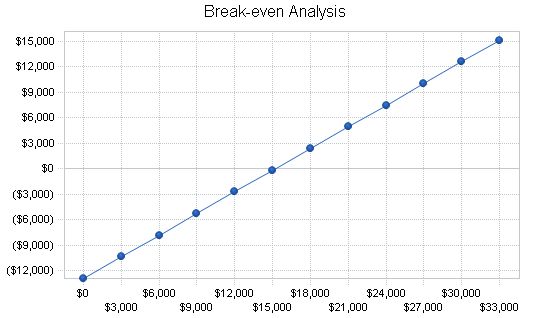
Break-even Analysis:
Monthly Revenue Break-even: $15,225
Assumptions:
– Average Percent Variable Cost: 15%
– Estimated Monthly Fixed Cost: $12,941
Projected Profit and Loss:
The table below indicates the projected profit and loss.
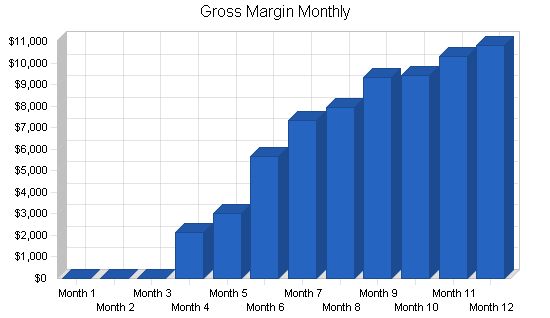
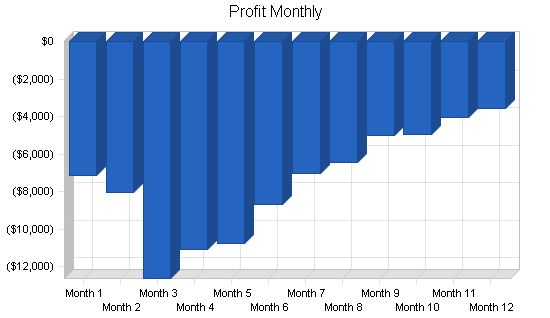
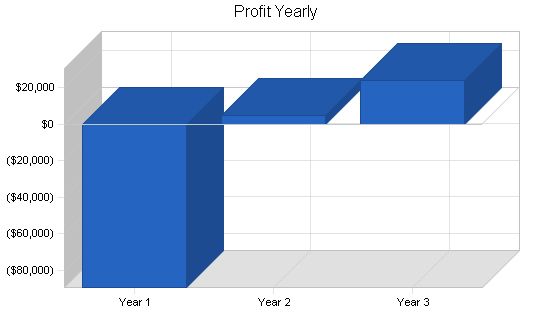
Pro Forma Profit and Loss
Year 1 Year 2 Year 3
Sales $77,635 $230,298 $261,991
Direct Cost of Sales $11,645 $34,545 $39,299
Other Costs of Sales $0 $0 $0
Total Cost of Sales $11,645 $34,545 $39,299
Gross Margin $65,990 $195,753 $222,692
Gross Margin % 85.00% 85.00% 85.00%
Expenses
Payroll $120,250 $152,000 $152,000
Sales and Marketing and Other Expenses $0 $0 $0
Depreciation $3,804 $317 $317
Rent $7,800 $7,800 $7,800
Utilities $1,800 $1,800 $1,800
Insurance $1,800 $1,800 $1,800
Payroll Taxes $18,038 $22,800 $22,800
Other $1,800 $1,800 $1,800
Total Operating Expenses $155,292 $188,317 $188,317
Profit Before Interest and Taxes ($89,301) $7,436 $34,375
EBITDA ($85,497) $7,753 $34,692
Interest Expense $73 $220 $120
Taxes Incurred $0 $2,165 $10,277
Net Profit ($89,374) $5,051 $23,979
Net Profit/Sales -115.12% 2.19% 9.15%
8.4 Projected Cash Flow
The following table and chart will indicate Projected Cash Flow.
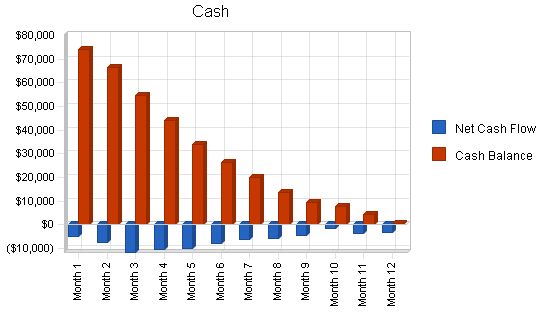
Pro Forma Cash Flow
| Pro Forma Cash Flow | |||
| Year 1 | Year 2 | Year 3 | |
| Cash Received | |||
| Cash from Operations | |||
| Cash Sales | $77,635 | $230,298 | $261,991 |
| Subtotal Cash from Operations | $77,635 | $230,298 | $261,991 |
| Additional Cash Received | |||
| Sales Tax, VAT, HST/GST Received | $0 | $0 | $0 |
| New Current Borrowing | $3,000 | $0 | $0 |
| New Other Liabilities (interest-free) | $0 | $0 | $0 |
| New Long-term Liabilities | $0 | $0 | $0 |
| Sales of Other Current Assets | $0 | $0 | $0 |
| Sales of Long-term Assets | $0 | $0 | $0 |
| New Investment Received | $0 | $0 | $0 |
| Subtotal Cash Received | $80,635 | $230,298 | $261,991 |
| Expenditures | Year 1 | Year 2 | Year 3 |
| Expenditures from Operations | |||
| Cash Spending | $120,250 | $152,000 | $152,000 |
| Bill Payments | $38,394 | $71,497 | $84,646 |
| Subtotal Spent on Operations | $158,644 | $223,497 | $236,646 |
| Additional Cash Spent | |||
| Sales Tax, VAT, HST/GST Paid Out | $0 | $0 | $0 |
| Principal Repayment of Current Borrowing | $300 | $1,000 | $1,000 |
| Other Liabilities Principal Repayment | $0 | $0 | $0 |
| Long-term Liabilities Principal Repayment | $0 | $0 | $0 |
| Purchase Other Current Assets | $0 | $0 | $0 |
| Purchase Long-term Assets | $0 | $0 | $0 |
| Dividends | $0 | $0 | $0 |
| Subtotal Cash Spent | $158,944 | $224,497 | $237,646 |
| Net Cash Flow | ($78,308) | $5,801 | $24,345 |
| Cash Balance | $692 | $6,492 | $30,837 |
Projected Balance Sheet
| Pro Forma Balance Sheet | |||
| Year 1 | Year 2 | Year 3 | |
| Assets | |||
| Current Assets | |||
| Cash | $692 | $6,492 | $30,837 |
| Other Current Assets | $7,000 | $7,000 | $7,000 |
| Total Current Assets | $7,692 | $13,492 | $37,837 |
| Long-term Assets | |||
| Long-term Assets | $19,000 | $19,000 | $19,000 |
| Accumulated Depreciation | $3,804 | $4,121 | $4,438 |
| Total Long-term Assets | $15,196 | $14,879 | $14,562 |
| Total Assets | $22,888 | $28,371 | $52,399 |
| Liabilities and Capital | Year 1 | Year 2 | Year 3 |
| Current Liabilities | |||
| Accounts Payable | $4,561 | $5,994 | $7,043 |
| Current Borrowing | $2,700 | $1,700 | $700 |
| Other Current Liabilities | $0 | $0 | $0 |
| Subtotal Current Liabilities | $7,261 | $7,694 | $7,743 |
| Long-term Liabilities | $0 | $0 | $0 |
| Total Liabilities | $7,261 | $7,694 | $7,743 |
| Paid-in Capital | $125,000 | $125,000 | $125,000 |
| Retained Earnings | ($20,000) | ($109,374) | ($104,323) |
| Earnings | ($89,374) | $5,051 | $23,979 |
| Total Capital | $15,626 | $20,677 | $44,656 |
| Total Liabilities and Capital | $22,888 | $28,371 | $52,399 |
| Net Worth | $15,626 | $20,677 | $44,656 |
| Ratio Analysis | ||||
| Year 1 | Year 2 | Year 3 | Industry Profile | |
| Sales Growth | 0.00% | 196.64% | 13.76% | 8.79% |
| Percent of Total Assets | ||||
| Other Current Assets | 30.58% | 24.67% | 13.36% | 44.18% |
| Total Current Assets | 33.61% | 47.56% | 72.21% | 76.27% |
| Long-term Assets | ||||
| Long-term Assets | 66.39% | |||
| General Assumptions | |||||||||||||
| Month 1 | Month 2 | Month 3 | Month 4 | Month 5 | Month 6 | Month 7 | Month 8 | Month 9 | Month 10 | Month 11 | Month 12 | ||
| 1 | 2 | 3 | 4 | 5 | 6 | 7 | 8 | 9 | 10 | 11 | 12 | ||
| 0 | 0 | 0 | 0 | 0 | 0 | 0 | 0 | 0 | 0 | 0 | 0 | ||
Pro Forma Profit and Loss:
| Pro Forma Profit and Loss | |||||||||||||
| Month 1 | Month 2 | Month 3 | Month 4 | Month 5 | Month 6 | Month 7 | Month 8 | Month 9 | Month 10 | Month 11 | Month 12 | ||
| $0 | $0 | $0 | $2,500 | $3,545 | $6,681 | $8,641 | $9,312 | $10,987 | $11,110 | $12,135 | $12,724 | ||
| $0 | $0 | $0 | $375 | $532 | $1,002 | $1,296 | $1,397 | $1,648 | $1,667 | $1,820 | $1,909 | ||
| $0 | $0 | $0 | $375 | $532 | $1,002 | $1,296 | $1,397 | $1,648 | $1,667 | $1,820 | $1,909 | ||
| $0 | $0 | $0 | $2,125 | $3,013 | $5,679 | $7,345 | $7,916 | $9,339 | $9,444 | $10,315 | $10,816 | ||
| 0.00% | 0.00% | 0.00% | 85.00% | 85.00% | 85.00% | 85.00% | 85.00% | 85.00% | 85.00% | 85.00% | 85.00% | ||
| $7,167 | $8,030 | $12,630 | $13,205 | $13,780 | $14,355 | $14,355 | $14,355 | $14,355 | $14,355 | $14,355 | $14,355 | ||
| ($7,167) | ($8,030) | ($12,630) | ($11,080) | ($10,766) | ($8,676) | ($7,010) | ($6,439) | ($5,016) | ($4,911) | ($4,040) | ($3,539) | ||
| ($6,850) | ($7,713) | ($12,313) | ($10,763) | ($10,449) | ($8,359) | ($6,693) | ($6,122) | ($4,699) | ($4,594) | ($3,723) | ($3,222) | ||
| $0 | $0 | $0 | $0 | $0 | $0 | $0 | $0 | $0 | $25 | $25 | $23 | ||
| $0 | $0 | $0 | $0 | $0 | $0 | $0 | $0 | $0 | $0 | $0 | $0 | ||
| $0 | $0 | $0 | $0 | $0 | $0 | $0 | $0 | $0 | $0 | $0 | $0 | ||
| $0 | $0 | $0 | $0 | $0 | $0 | $0 | $0 | $0 | $0 | $0 | $0 | ||
Pro Forma Cash Flow:
| Pro Forma Cash Flow | |||||||||||||
| Month 1 | Month 2 | Month 3 | Month 4 | Month 5 | Month 6 | Month 7 | Month 8 | Month 9 | Month 10 | Month 11 | Month 12 | ||
| $0 | $0 | $0 | $2,500 | $3,545 | $6,681 | $8,641 | $9,312 | $10,987 | $11,110 | $12,135 | $12,724 | ||
| $0 | $0 | $0 | $2,500 | $3,545 | $6,681 | $8,641 | $9,312 | $10,987 | $14,110 | $12,135 | $12,724 | ||
| $0 | $0 | $0 | |||||||||||
| Pro Forma Balance Sheet | |||||||||||||
| Month 1 | Month 2 | Month 3 | Month 4 | Month 5 | Month 6 | Month 7 | Month 8 | Month 9 | Month 10 | Month 11 | Month 12 | ||
| Assets | Starting Balances | ||||||||||||
| Current Assets | |||||||||||||
| Cash | $79,000 | $73,938 | $66,335 | $54,602 | $44,275 | $34,049 | $26,218 | $19,809 | $13,785 | $9,329 | $7,752 | $4,153 | $692 |
| Other Current Assets | $7,000 | ||||||||||||
| Total Current Assets | $86,000 | $80,938 | $73,335 | $61,602 | $51,275 | $41,049 | $33,218 | $26,809 | $20,785 | $16,329 | $14,752 | $11,153 | $7,692 |
| Long-term Assets | |||||||||||||
| Long-term Assets | $19,000 | ||||||||||||
| Accumulated Depreciation | $0 | $317 | $634 | $951 | $1,268 | $1,585 | $1,902 | $2,219 | $2,536 | $2,853 | $3,170 | $3,487 | $3,804 |
| Total Long-term Assets | $19,000 | $18,683 | $18,366 | $18,049 | $17,732 | $17,415 | $17,098 | $16,781 | $16,464 | $16,147 | $15,830 | $15,513 | $15,196 |
| Total Assets | $105,000 | $99,621 | $91,701 | $79,651 | $69,007 | $58,464 | $50,316 | $43,590 | $37,249 | $32,476 | $30,582 | $26,666 | $22,888 |
| Liabilities and Capital | |||||||||||||
| Current Liabilities | |||||||||||||
| Accounts Payable | $0 | $1,788 | $1,897 | $2,477 | $2,912 | $3,136 | $3,663 | $3,947 | $4,045 | $4,288 | $4,330 | $4,478 | $4,561 |
| Current Borrowing | $0 | $0 | $0 | $0 | $0 | $0 | $0 | $0 | $0 | $0 | $3,000 | $3,000 | $2,700 |
| Other Current Liabilities | $0 | ||||||||||||
| Subtotal Current Liabilities | $0 | $1,788 | $1,897 | $2,477 | $2,912 | $3,136 | $3,663 | $3,947 | $4,045 | $4,288 | $7,330 | $7,478 | $7,261 |
| Long-term Liabilities | $0 | ||||||||||||
| Total Liabilities | $0 | $1,788 | $1,897 | $2,477 | $2,912 | $3,136 | $3,663 | $3,947 | $4,045 | $4,288 | $7,330 | $7,478 | $7,261 |
| Paid-in Capital | $125,000 | ||||||||||||
| Retained Earnings | ($20,000) | ||||||||||||
| Earnings | $0 | ($7,167) | ($15,197) | ($27,826) | ($38,906) | ($49,672) | ($58,347) | ($65,357) | ($71,796) | ($76,812) | ($81,748) | ($85,813) | ($89,374) |
| Total Capital | $105,000 | $97,833 | $89,804 | $77,174 | $66,095 | $55,328 | $46,653 | $39,643 | $33,204 | $28,188 | $23,252 | $19,187 | $15,626 |
| Total Liabilities and Capital | $105,000 | $99,621 | $91,701 | $79,651 | $69,007 | $58,464 | $50,316 | $43,590 | $37,249 | $32,476 | $30,582 | $26,666 | $22,888 |
| Net Worth | $105,000 | $97,833 | $89,804 | $77,174 | $66,095 | $55,328 | $46,653 | $39,643 | $33,204 | $28,188 | $23,252 | $19,187 | $15,626 |

Business Plan Outline
- Executive Summary
- Company Summary
- Services
- Market Analysis Summary
- Strategy and Implementation Summary
- Management Summary
- Financial Plan
- Appendix
Hello!
I’m Andrew Brooks, a seasoned finance consultant from the USA and the mind behind phonenumber247.com.
My career is built on a foundation of helping individuals and businesses thrive financially in an ever-changing economic landscape. At phonenumber247.com, my aim is to demystify the complex world of finance, providing clear, actionable advice that can help you navigate your financial journey with confidence. Whether it’s personal finance management, investment strategies, or understanding the nuances of market dynamics, I’m here to share insights and tools that can propel you towards your financial goals.
Welcome to my digital space, where every piece of advice is a step closer to financial clarity and success!
